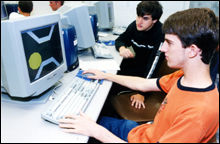By JENNIFER LEWANDOWSKI
Reporter Assistant Editor
A dozen of the area's best and brightest high school students are getting
the chance to let loose their imaginations this summer with an intensive
workshop in scientific visualization and virtual reality cosponsored
by the New York State Center for Engineering Design and Industrial Innovation
(NYSCEDII) and the Center for Computational Research (CCR), both at
UB.
The free, two-week workshop, which began June 25, offered an introduction
to the cutting-edge technologies available at UB's centers. The workshop,
which for two years has spotlighted computational chemistry and the
CCR—one of the world's leading academic supercomputing sites—turned
its attention this year to NYSCEDII for its expertise in visualization
and virtual reality.
| |
 |
| |
Joseph
Bauser works on a project using VRML—virtual reality modeling
language—as Jake Gadikian looks on. The students were working
in the Furnas Hall computer lab. |
| |
Photo:
Nancy J. Parisi |
Not only were students exposed to the integration of visualization
and virtual reality in business and research, they also developed and
created a final project, said Eliot Winer, associate director of NYSCEDII
and facilitator of this year's workshop.
"We introduced them to some technology, and showed them how to program
things, and then we steered them toward a project," Winer said, noting
that the 9-to-5 days were split between instruction and hands-on activity,
with greater emphasis on the latter. "The ideas really come from them.
It can be anything they want to do."
The students—predominantly high school sophomores and juniors who
excel in mathematics and science—came ready to work.
"These are kids who really want to learn about high-performance computing
and high-end visualization," said Russ Miller, director of CCR, noting
that they receive no high school or college credit for the workshop.
Accepted applicants, it seems, all have one thing in common—ambition.
Case in point: One student who attended the workshop this summer operates
his own Web company.
"We're looking for the best and brightest students in Western New
York," Miller noted. Whether inspiring interest in math, science, engineering
or computing at UB, or elsewhere, Miller said "a high-end program for
local high school students is just the right thing to do for a university
with these state-of-the-art capabilities."
Kevin Chugh, a research associate with NYSCEDII who in large part
coordinated programming for this summer's session, said the workshop
is a unique service to the community, given the short list of institutions
in the United States that pack such a powerful one-two punch of high-end
computing and visualization technology.
"(UB) is one of only a handful that has this kind of facility, expertise,
staff and faculty that are doing this," he said.
In recognition of its service to the community, Praxair Inc., a frequent
partner with CCR and NYSCEDII on numerous projects, awarded CCR a $4,000
grant to support the program this year and next. Praxair is a global
supplier of industrial gases with local operations in Tonawanda.
UB has been fortunate to welcome back some of the participants from
previous workshops as university students. And those who have gone onto
other institutions often come back during their summers to work at CCR,
Miller said.
Yan Shtarker, a computer engineering major entering his third year
at UB, already was planning to attend UB when he was accepted into the
workshop as a senior at Williamsville East High School.
In his freshman year, Shtarker continued his relationship with CCR
as a work-study student, and, as a research assistant his second year,
was granted a fellowship to study supercomputing through the Department
of Energy at the Oak Ridge Laboratory in Oak Ridge, Tenn.
Other students from the first workshop have returned—now as UB students—to
teach the introductory material to newcomers.
"We're holding up our own, and training our own," Winer said. "When
they leave here, they have a set of skills they continue to use. It's
immensely rewarding, even to us, to see what these kids can do in two
weeks."
Workshop faculty and staff volunteer their teaching time.
"It is critical that high-end technology reaches the scientists of
tomorrow while they are still impressionable," Miller said. Education
is part of the joint mission of CCR, established in January 1999, and
NYSCEDII, up and running since October 2000.
"As much as scientists and engineers who work in these areas love
to talk about bits and bytes, it is great to see how much they enjoy
working to bring state-of-the-art technology to these young minds—because
they are the future."

